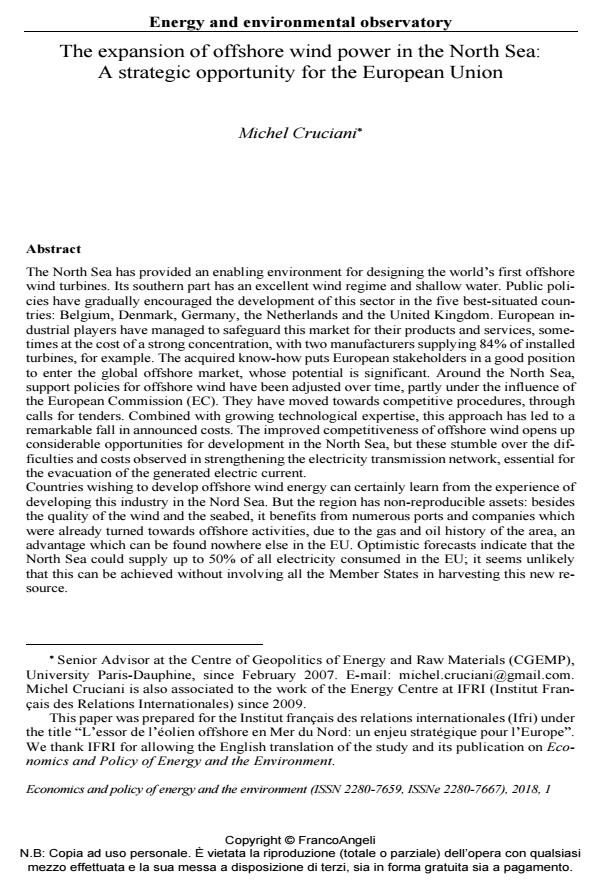The expansion of offshore wind power in the North Sea: A strategic opportunity for the European Union
Journal title ECONOMICS AND POLICY OF ENERGY AND THE ENVIRONMENT
Author/s Michel Cruciani
Publishing Year 2019 Issue 2018/1
Language English Pages 24 P. 5-28 File size 574 KB
DOI 10.3280/EFE2018-001001
DOI is like a bar code for intellectual property: to have more infomation
click here
Below, you can see the article first page
If you want to buy this article in PDF format, you can do it, following the instructions to buy download credits

FrancoAngeli is member of Publishers International Linking Association, Inc (PILA), a not-for-profit association which run the CrossRef service enabling links to and from online scholarly content.
The North Sea has provided an enabling environment for designing the world’s first offshore wind turbines. Its southern part has an excellent wind regime and shallow water. Public policies have gradually encouraged the development of this sector in the five best-situated countries: Belgium, Denmark, Germany, the Netherlands and the United Kingdom. European industrial players have managed to safeguard this market for their products and services, sometimes at the cost of a strong concentration, with two manufacturers supplying 84% of installed turbines, for example. The acquired know-how puts European stakeholders in a good position to enter the global offshore market, whose potential is significant. Around the North Sea, support policies for offshore wind have been adjusted over time, partly under the influence of the European Commission (EC). They have moved towards competitive procedures, through calls for tenders. Combined with growing technological expertise, this approach has led to a remarkable fall in announced costs. The improved competitiveness of offshore wind opens up considerable opportunities for development in the North Sea, but these stumble over the difficulties and costs observed in strengthening the electricity trans-mission network, essential for the evacuation of the generated electric current. Countries wishing to develop offshore wind energy can certainly learn from the experience of developing this industry in the Nord Sea. But the region has non-reproducible assets: besides the quality of the wind and the seabed, it benefits from numerous ports and companies which were already turned towards offshore activities, due to the gas and oil history of the area, an advantage which can be found nowhere else in the EU. Optimistic forecasts indicate that the North Sea could supply up to 50% of all electricity consumed in the EU; it seems unlikely that this can be achieved without involving all the Member States in harvesting this new resource.
Keywords: Offshore wind, electricity, market power, Germany, oligopolistic market.
Jel codes: L13, Q28, O25
- Deep-Learning-Based Pitch Controller for Floating Offshore Wind Turbine Systems with Compensation for Delay of Hydraulic Actuators Chan Roh, in Energies /2022 pp.3136
DOI: 10.3390/en15093136 - Catalytic Industrial Policy—in concordia varietas Mario Holzner, in Journal of Industrial and Business Economics /2025 pp.805
DOI: 10.1007/s40812-025-00360-5 - Control Strategies for Floating Offshore Wind Turbine: Challenges and Trends Tom Salic, Jean Frédéric Charpentier, Mohamed Benbouzid, Marc Le Boulluec, in Electronics /2019 pp.1185
DOI: 10.3390/electronics8101185
Michel Cruciani, The expansion of offshore wind power in the North Sea: A strategic opportunity for the European Union in "ECONOMICS AND POLICY OF ENERGY AND THE ENVIRONMENT" 1/2018, pp 5-28, DOI: 10.3280/EFE2018-001001